Résultats de recherche de titre
Articles 1495141 à 1495160 sur 1497515
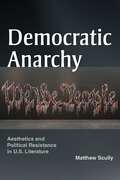
Democratic Anarchy: Aesthetics and Political Resistance in U.S. Literature
Par Matthew Scully. 2024
A dramatic and necessary rethinking of the meaning of DemocracyDemocratic Anarchy grapples with an uncomfortable but obvious truth inimical to…
democracy: both aesthetics and politics depend on the structuring antagonism of inclusion and exclusion. Yet in Democratic Anarchy, Matthew Scully asks, how can “the people” be represented in a way that acknowledges what remains unrepresentable? What would it mean to face up to the constitutive exclusions that haunt U.S. democracy and its anxious fantasies of equality?Synthesizing a broad range of theoretical traditions and interlocutors—including Lacan, Rancière, Edelman, and Hartman—Democratic Anarchy polemically declares that there has never been, nor can there ever be, a realized democracy in the U.S. because democracy always depends on the hierarchical institution of a formal order by one part of the population over another. Engaging with an expansive corpus of American literature and art (Harriet Jacobs, Nathaniel Hawthorne, Louis Zukofsky, Thomas Pynchon, Toni Morrison, Theresa Hak Kyung Cha, Nari Ward, Ocean Vuong, and Safiya Sinclair), Democratic Anarchy argues that many liberal concepts and institutions are in fact structurally opposed to democratic equality because they depend on regulating what can appear and in what form.By focusing on works that disrupt this regulatory impulse, Scully shows how rhetorical strategies of interruption, excess, and disorder figure the anarchic equality that inegalitarian fantasies of democracy disavow. Democratic Anarchy develops a rigorous theory of equality that refuses to repeat the inequalities against which it positions itself, and it does so by turning to moments of resistance—both aesthetic and political—inaugurated by the equality that inheres in and antagonizes the order of things.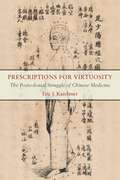
Prescriptions for Virtuosity: The Postcolonial Struggle of Chinese Medicine
Par Eric I. Karchmer. 2022
Although Chinese medicine is assumed to be a timeless healing tradition, the encounter with modern biomedicine threatened its very existence…
and led to many radical changes. Prescriptions for Virtuosity tells the story of how doctors of Chinese medicine have responded to the global dominance of biomedicine and developed new forms of virtuosity to keep their clinical practice relevant in contemporary Chinese society.Based on extensive ethnographic and historical research, the book documents the strategies of Chinese medicine doctors to navigate postcolonial power inequalities. Doctors have followed two seemingly contradictory courses of action. First, they have emphasized the unique “Chinese” characteristics of their practice, defining them against the perceived strengths of biomedicine, and producing an ontological divide between the two medical systems. These oppositions have inadvertently marginalized Chinese medicine, making it seem appropriate for clinical use only when biomedical solutions are lacking. Second, doctors have found points of convergence to facilitate the blending of the two medical practices, producing innovative solutions to difficult clinical problems.Prescriptions for Virtuosity examines how the postcolonial condition can generate not only domination but hybridity. Karchmer shows, for example, how the clinical methodology of “pattern discrimination and treatment determination” bianzheng lunzhi, which is today celebrated as the quintessential characteristic of Chinese medicine, is a twentieth-century invention. When subjected to the institutional standardizations of hospital practice, bianzheng lunzhi can lead to an impoverished form of medicine. But in the hands of a virtuoso physicians, it becomes a dynamic tool for moving between biomedicine and Chinese medicine to create innovative new therapies.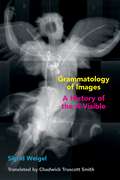
Grammatology of Images: A History of the A-Visible (Commonalities)
Par Sigrid Weigel. 2015
Grammatology of Images radically alters how we approach images. Instead of asking for the history, power, or essence of images,…
Sigrid Weigel addresses imaging as such. The book considers how something a-visible gets transformed into an image. Weigel scrutinizes the moment of mis-en-apparition, of making an appearance, and the process of concealment that accompanies any imaging.Weigel reinterprets Derrida’s and Freud’s concept of the trace as that which must be thought before something exists. In doing so, she illuminates the threshold between traces and iconic images, between something immaterial and its pictorial representation. Chapters alternate between general accounts of the line, the index, the effigy, and the cult-image, and case studies from the history of science, art, politics, and religion, involving faces as indicators of emotion, caricatures as effigies of defamation, and angels as embodiments of transcendental ideas.Weigel’s approach to images illuminates fascinating, unexpected correspondences between premodern and contemporary image-practices, between the history of religion and the modern sciences, and between things that are and are not understood as art.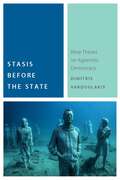
Stasis Before the State: Nine Theses on Agonistic Democracy (Commonalities)
Par Dimitris Vardoulakis. 2018
This book critiques the relation between sovereignty and democracy. Across nine theses, Vardoulakis argues that sovereignty asserts its power by…
establishing exclusions: the sovereign excluding other citizens from power and excludes refugees and immigrants from citizenship. Within this structure, to resist sovereignty is to reproduce the logic of exclusion characteristic of sovereignty.In contrast to this “ruse of sovereignty,” Vardoulakis proposes an alternative model for political change. He argues that democracy can be understood as the structure of power that does not rely on exclusions and whose relation to sovereignty is marked not by exclusion but of incessant agonism.The term stasis, which refers both to the state and to revolution against it, offers a tension that helps to show how the democratic imperative is presupposed by the logic of sovereignty, and how agonism is more primary than exclusion. In elaborating this ancient but only recently recovered concept of stasis, Vardoulakis illustrates the radical potential of democracy to move beyond the logic of exclusion and the ruse of sovereignty.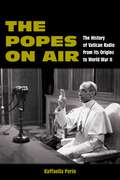
The story of the origin of Vatican Radio provides a unique look at the history of World War IIThe book…
offers the first wide-ranging study on the history of Vatican Radio from its origins (1931) to the end of Pius XII’s pontificate (1958) based on unpublished sources. The opening of the Secret Vatican Archives on the records regarding Pius XII will shed light on the most controversial pontificate of the 20th century. Moreover, the recent rearrangement of the Vatican media provided the creation of a multimedia archive that is still in Fieri.This research is an original point of view on the most relevant questions concerning these decades: the relation of the Catholic Church with the Fascist regimes and Western democracies; the attitude toward anti-Semitism and the Shoah in Europe, and in general toward the total war; the relationship of the Holy See with the new media in the mass society; the questions arisen in the after-war period such as the Christian Democratic Party in Italy; the new role of women; and anti-communism and the competition for the consensus in the social and moral order in a secularized society.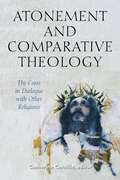
The central Christian belief in salvation through the suffering, death, and resurrection of Jesus Christ remains one of the most…
intractable mysteries of Christian faith. Throughout history, it has given rise to various theories of atonement, many of which have been subject to critique as they no longer speak to contemporary notions of evil and sin or to current conceptions of justice. One of the important challenges for contemporary Christian theology thus involves exploring new ways of understanding the salvific meaning of the cross.In Atonement and Comparative Theology, Christian theologians with expertise in Judaism, Islam, Hinduism, Buddhism, Daoism, and African Religions reflect on how engagement with these traditions sheds new light on the Christian understanding of atonement by pointing to analogous structures of sin and salvation, drawing attention to the scandal of the cross as seen by the religious other, and re-interpreting aspects of the Christian understanding of atonement. Together, they illustrate the possibilities for comparative theology to deepen and enrich Christian theological reflection.
Sodomscapes: Hospitality in the Flesh
Par Lowell Gallagher. 2017
Sodomscapes presents a fresh approach to the story of Lot’s wife, as it’s been read across cultures and generations. In…
the process, it reinterprets foundational concepts of ethics, representation, and the body. While the sudden mutation of Lot’s wife in the flight from Sodom is often read to confirm our antiscopic bias, a rival tradition emphasizes the counterintuitive optics required to nurture sustainable habitations for life in view of its unforeseeable contingency.Whether in medieval exegesis, Russian avant-garde art, Renaissance painting, or today’s Dead Sea health care tourism industry, the repeated desire to reclaim Lot’s wife turns the cautionary emblem of the mutating woman into a figural laboratory for testing the ethical bounds of hospitality. Sodomscape—the book’s name for this gesture—revisits touchstone moments in the history of figural thinking and places them in conversation with key thinkers of hospitality. The book’s cumulative perspective identifies Lot’s wife as the resilient figure of vigilant dwelling, whose in-betweenness discloses counterintuitive ways of understanding what counts as a life amid divergent claims of being-with and being-for.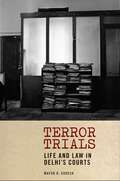
Terror Trials: Life and Law in Delhi's Courts (Thinking from Elsewhere)
Par Mayur R. Suresh. 2023
Honorable Mention, Bernard S. Cohn Book PrizeAn ethnography of terrorism trials in Delhi, India, this book explores what modes of…
life are made possible in the everyday experience of the courtroom. Mayur Suresh shows how legal procedures and technicalities become the modes through which courtrooms are made habitable. Where India’s terror trials have come to be understood by way of the expansion of the security state and displays of Hindu nationalism, Suresh elaborates how they are experienced by defendants in a quite different way, through a minute engagement with legal technicalities.Amidst the grinding terror trials—which are replete with stories of torture, illegal detention and fabricated charges—defendants school themselves in legal procedures, became adept petition writers, build friendships with police officials, cultivate cautious faith in the courts and express a deep sense of betrayal when this trust is belied. Though seemingly mundane, legal technicalities are fraught and highly contested, and acquire urgent ethical qualities in the life of a trial: the file becomes a space in which the world can be made or unmade, the petition a way of imagining a future, and investigative and courtroom procedures enable the unexpected formation of close relationships between police and terror-accused.In attending to the ways in which legal technicalities are made to work in everyday interactions among lawyers, judges, accused terrorists, and police, Suresh shows how human expressiveness, creativity and vulnerability emerge through the law.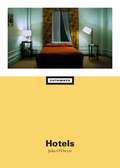
Hotels (Cutaways)
Par Jules O'Dwyer. 2025
From Marienbad to the Bates Motel, cinematic hotels are more than a mere backdrop to a film’s action. They actively…
scaffold the formal, aesthetic, and narrative possibilities of cinema. This book takes a journey through spaces of temporary dwelling—hotels, inns, and motels—to delve into the dynamics and contradictions that structure modern life.Along the way, O’Dwyer considers questions of plot and eroticism, labor and globalization, and the ethics and economics of hospitality. Drawing on a broad array of films from European art cinema to experimental adult media, and placing cinema into dialogue with film theory and media history, Hotels explores both how and why the hotel has such a strong purchase on the cinematic imaginary.
Thinking with Adorno: The Uncoercive Gaze (Idiom: Inventing Writing Theory)
Par Gerhard Richter. 2019
What Theodor W. Adorno says cannot be separated from how he says it. By the same token, what he thinks…
cannot be isolated from how he thinks it. The central aim of Richter’s book is to examine how these basic yet far-reaching assumptions teach us to think with Adorno—both alongside him and in relation to his diverse contexts and constellations. These contexts and constellations range from aesthetic theory to political critique, from the problem of judgment to the difficulty of inheriting a tradition, from the primacy of the object to the question of how to lead a right life within a wrong one.Richter vividly shows how Adorno’s highly suggestive—yet often overlooked—concept of the “uncoercive gaze” designates a specific kind of comportment in relation to an object of critical analysis: It moves close to the object and tarries with it while struggling to decipher the singularities and non-identities that are lodged within it, whether the object is an idea, a thought, a concept, a text, a work of art, an experience, or a problem of political or sociological theory.Thinking with Adorno’s uncoercive gaze not only means following the fascinating paths of his own work; it also means extending hospitality to the ghostly voices of others. As this book shows, Adorno is best understood as a thinker in dialogue, whether with long-deceased predecessors in the German tradition such as Kant and Hegel, with writers such as Kafka, with contemporaries such as Benjamin and Arendt, or with philosophical voices that succeeded him, such as those of Derrida and Agamben.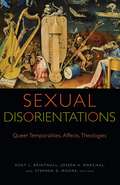
Sexual Disorientations: Queer Temporalities, Affects, Theologies (Transdisciplinary Theological Colloquia)
Par Kent L. Brintnall, Joseph A. Marchal, and Stephen D. Moore. 2018
Sexual Disorientations brings some of the most recent and significant works of queer theory into conversation with the overlapping fields…
of biblical, theological and religious studies to explore the deep theological resonances of questions about the social and cultural construction of time, memory, and futurity. Apocalyptic, eschatological and apophatic languages, frameworks, and orientations pervade both queer theorizing and theologizing about time, affect, history and desire. The volume fosters a more explicit engagement between theories of queer temporality and affectivity and religious texts and discourses.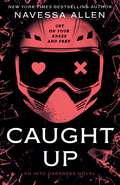
From the author of TikTok's favourite dark and steamy romance, Lights Out, comes Navessa Allen's second book in the New…
York Times bestselling Into Darkness trilogy I want this woman, and I'm a man who always gets what he wants. Nico 'Junior' Trocci knows Lauren Marchetti is off limits. Men like him don't get to have women like her. It's why he pushed her away in high school and still keeps his distance. But Junior follows Lauren online, and now that the shy, bookish girl he remembers is gone, he can't stop obsessing over the strikingly beautiful woman who has taken her place.He's ruthless; a walking red flag. Good thing red is my favorite color. Lauren 'Lo' Marchetti knows Junior is dangerous. He broke her heart once and she won't let him do it again. But as their flirtatious encounters escalate, Lauren starts to remember why she fell for the brooding antihero all those years ago.As old obstacles resurface, Junior and Lauren are forced to face their true feelings for each other and decide just how far they're willing to go for a second chance at love.Caught Up is a fast-paced dark romance with a morally grey male lead. Some themes and scenes may be disturbing to readers. Please check the content warning at the beginning of the book.18+ mature content. Not suitable for younger readers. Readers LOVE Lights Out! 'Hilarious, and wickedly sexy. Yes Josh is a bit of a stalker, but he's a golden retriever one' ⭐⭐⭐⭐⭐'I absolutely adored this book . . . perfect in every single way!' ⭐⭐⭐⭐⭐'Josh and Aly are both magnificent and the spice is next level' ⭐⭐⭐⭐⭐'Really fun, made me laugh so many times I lost count' ⭐⭐⭐⭐⭐'Quite literally perfect. I wanted something spicy but fun and it more than delivered!' ⭐⭐⭐⭐⭐'Proving that a dark romance can still have humour . . . dark of course!!!' ⭐⭐⭐⭐⭐'PERFECTION!' ⭐⭐⭐⭐⭐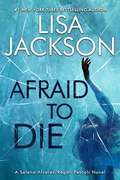
A Montana serial killer is out to taunt and terrorize Detective Selena Alvarez in this psychological thriller by the #1 New…
York Times bestselling author. The town of Grizzly Falls, Montana, is still on edge in the wake of a serial killer&’s capture. Thanks to Detectives Selena Alvarez and Regan Pescoli, the nightmare is over. But a new one is about to unfold. There are two victims so far—their bodies found frozen solid and deliberately displayed. Both are women Selena knew. And each wears a piece of her jewelry. Selena, Regan, and the entire department are on the case, as is P.I. Dylan O'Keefe—a man Selena got too close to once before. But this killer already knows too much about Selena's secret terror, her flaws, and the past she's tried to outrun. And soon he'll show her that she has every reason to be afraid. Selena's partner, Detective Regan Pescoli, and the entire department are on the case, as is P.I. Dylan O'Keefe--a man Selena got too close to once before. But this killer already knows too much about Selena's secret terror, her flaws, and the past she's tried to outrun. And soon he'll show her that she has every reason to be afraid. . .
Dynamic Judaism: The Essential Writings of Mordecai M. Kaplan
Par Mel Scult, Emanuel Goldsmith. 1985
Available in a new digital edition with reflowable text suitable for e-readersMordecai M. Kaplan was born in a small Lithuanian…
town on the outskirts of Vilna on a Friday evening in June of 1881. Kaplan was raised in a predominately Jewish atmosphere, which is shown by the fact that he knew his day of birth only by the Jewish calendar until he went to the New York Public Library as a young man to look up the corresponding date. His family was extremely traditional, and his father, Israel Kaplan, was a learned man.Kaplan's concept of Judaism as an evolving religious civilization was widely influential in 20th-century American Jewish life, and his founding of the Reconstructionist Rabbinical College created a new denomination. This book contains a biographical essay and excerpts from all of his major works.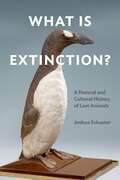
What Is Extinction?: A Natural and Cultural History of Last Animals
Par Joshua Schuster. 2023
WINNER, 25th ANNUAL SUSANNE M. GLASSCOCK BOOK PRIZELife on Earth is facing a mass extinction event of our own making.…
Human activity is changing the biology and the meaning of extinction. What Is Extinction? examines several key moments that have come to define the terms of extinction over the past two centuries, exploring instances of animal and human finitude and the cultural forms used to document and interpret these events.Offering a critical theory for the critically endangered, Joshua Schuster proposes that different discourses of limits and lastness appear in specific extinction events over time as a response to changing attitudes toward species frailty. Understanding these extinction events also involves examining what happens when the conceptual and cultural forms used to account for species finitude are pressed to their limits as well. Schuster provides close readings of several case studies of extinction that bring together environmental humanities and multispecies methods with media-specific analyses at the terminus of life.What Is Extinction? delves into the development of last animal photography, the anthropological and psychoanalytic fascination with human origins and ends, the invention of new literary genres of last fictions, the rise of new extreme biopolitics in the Third Reich that attempted to change the meaning of extinction, and the current pursuit of de-extinction technologies. Schuster offers timely interpretations of how definitions and visions of extinction have changed in the past and continue to change in the present.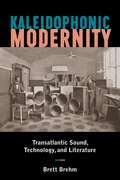
Kaleidophonic Modernity: Transatlantic Sound, Technology, and Literature
Par Brett Brehm. 2023
What stories remain hidden behind one of the most significant inventions of the nineteenth century? Kaleidophonic Modernity reexamines the development…
of mechanical sound recording technology by charting the orbits of writers, scientists, and artists in France and the United States. Working between comparative literature, the history of science, and urban studies, Brehm builds a bridge between visual culture and sound studies.Kaleidophonic Modernity places the poet and inventor Charles Cros and his lover, the celebrated concert pianist and salonnière Nina de Villard at the heart of modern aesthetic and scientific vanguards. Cros's scientific endeavors ranged from color photography, to telecommunications, to mechanical sound reproducibility. In his poetry the Surrealists found an ancestor and inspiration. His literary and scientific works prove startling and relevant to predicaments of technological media in his own time and ours. For nearly twenty years Nina de Villard presided over a supremely daring intellectual salon. There, she welcomed manifold literary, artistic, and musical luminaries into a veritable crucible of the artistic avant-garde and precursor to the famous Chat Noir cabaret. Together, these two forgotten but pivotal figures, Cros and Villard, help reframe our thinking on Edgar Allan Poe, Charles Baudelaire, and Walt Whitman, icons of urban modernity who can now be seen and heard in a kaleidophonic light, one that offers a compelling new perspective on modern mediascapes.In elaborating this transatlantic phenomenon, Kaleidophonic Modernity illuminates the prehistory of the phonograph as it intersects with the aesthetics of sound reproducibility, Franco-American literary exchange, Poe’s aesthetic and intellectual legacy, the sounds of modern cities and technologies, and the genealogy of audiovisual experimentation found in such movements as Dada, Futurism, and the sound art of today.
Fueling Culture: 101 Words for Energy and Environment
Par Jennifer Wenzel, Patricia Yaeger. 2017
How has our relation to energy changed over time? What differences do particular energy sources make to human values, politics,…
and imagination? How have transitions from one energy source to another—from wood to coal, or from oil to solar to whatever comes next—transformed culture and society? What are the implications of uneven access to energy in the past, present, and future? Which concepts and theories clarify our relation to energy, and which just get in the way? Fueling Culture offers a compendium of keywords written by scholars and practitioners from around the world and across the humanities and social sciences. These keywords offer new ways of thinking about energy as both the source and the limit of how we inhabit culture, with the aim of opening up new ways of understanding the seemingly irresolvable contradictions of dependence upon unsustainable energy forms.Fueling Culture brings together writing that is risk-taking and interdisciplinary, drawing on insights from literary and cultural studies, environmental history and ecocriticism, political economy and political ecology, postcolonial and globalization studies, and materialisms old and new.Keywords in this volume include: Aboriginal, Accumulation, Addiction, Affect, America, Animal, Anthropocene, Architecture, Arctic, Automobile, Boom, Canada, Catastrophe, Change, Charcoal, China, Coal, Community, Corporation, Crisis, Dams, Demand, Detritus, Disaster, Ecology, Electricity, Embodiment, Ethics, Evolution, Exhaust, Fallout, Fiction, Fracking, Future, Gender, Green, Grids, Guilt, Identity, Image, Infrastructure, Innervation, Kerosene, Lebenskraft, Limits, Media, Metabolism, Middle East, Nature, Necessity, Networks, Nigeria, Nuclear, Petroviolence, Photography, Pipelines, Plastics, Renewable, Resilience, Risk, Roads, Rubber, Rural, Russia, Servers, Shame, Solar, Spill, Spiritual, Statistics, Surveillance, Sustainability, Tallow, Texas, Textiles, Utopia, Venezuela, Whaling, Wood, Work For a full list of keywords in and contributors to this volume, please go to: http://ow.ly/4mZZxV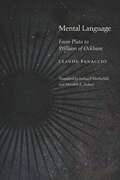
Mental Language: From Plato to William of Ockham (Medieval Philosophy: Texts and Studies)
Par Claude Panaccio. 2017
The notion that human thought is structured like a language, with a precise syntax and semantics, has been pivotal in…
recent philosophy of mind. Yet it is not a new idea: it was systematically explored in the fourteenth century by William of Ockham and became central in late medieval philosophy. Mental Language examines the background of Ockham's innovation by tracing the history of the mental language theme in ancient and medieval thought.Panaccio identifies two important traditions: one philosophical, stemming from Plato and Aristotle, and the other theological, rooted in the Fathers of the Christian Church. The study then focuses on the merging of the two traditions in the Middle Ages, as they gave rise to detailed discussions over the structure of human thought and its relations with signs and language. Ultimately, Panaccio stresses the originality and significance of Ockham's doctrine of the oratio mentalis (mental discourse) and the strong impression it made upon his immediate successors.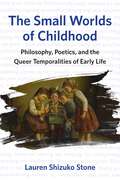
The Small Worlds of Childhood: Philosophy, Poetics, and the Queer Temporalities of Early Life
Par Lauren Shizuko Stone. 2025
The Small Worlds of Childhood argues that prose representations of bourgeois childhood contain surprising opportunities to reflect on the temporality…
of experience. In their narratives of children at home in their everyday worlds, Adalbert Stifter, Rainer Maria Rilke, and Walter Benjamin are not only able to shed a unique light on key issues in the history of philosophy. They also offer a queer critique of the normative expectation that the literature of childhood is oriented toward the future. Stone shows that when writers engage in philosophical storytelling, showing children tarrying in quotidian experience, they dislodge childhood from its nostalgic value to grown-ups and the heteronormative demand to grow up. Such stories of children as philosophical subjects thus take on their own lingering, backwards, or all together strange sense of time. Stone demonstrates the necessity of recognizing how texts on childhood—before and beyond Freud—engage literary language in the service of a variety of philosophical attitudes, reminding us how poetic techniques can tell us something extraordinary about moments of ordinary experience and the manner with which humans, and especially children, cognize the world. By bringing canonical German-language literary and philosophical traditions into conversation with current English-language queer approaches, Stone opens a queer counter-history of German and Austrian realist and modernist literature. This title is available from the publisher on an open-access basis.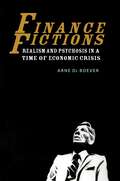
Finance Fictions: Realism and Psychosis in a Time of Economic Crisis
Par Arne De Boever. 2018
Finance Fictions takes the measure of what it means to live in a world ruled by high finance by examining…
the tension between psychosis and realism that plays out in the contemporary finance novel. When the things traded at the center of the economy cease to be things at all, but highly abstracted speculations, how do we come to see the real? What sorts of narrative can accurately approach the actual workings of a neoliberal economy marked by accelerating cycles of market crashes, economic and political crisis, and austerity?Revisiting such twentieth-century classics of the genre as Tom Wolfe's Bonfire of the Vanities and Bret Easton Ellis’s American Psycho, De Boever argues that the twenty-first century is witnessing the birth of a new kind of realistic novel that can make sense of complex financial instruments like collateralized debt obligations, credit default swaps, and digital algorithms operating at speeds faster than what human beings or computers can record. If in 1989 Wolfe could still urge novelists to work harder to “tame the billion-footed beast of reality,” today’s economic reality confronts us with a difference that is qualitative rather than quantitative: a new financial ontology requiring new modes of thinking and writing.Mobilizing the philosophical thought of Quentin Meillassoux in the close reading of finance novels by Robert Harris, Michel Houellebecq, Ben Lerner and less well-known works of conceptual writing such as Mathew Timmons’ Credit, Finance Fictions argues that realism is in for a speculative update if it wants to take on the contemporary economy—an “if” whose implications turn out to be deeply political. Part literary study and part philosophical inquiry, Finance Fictions seeks to contribute to a new mindset for creative and critical work on finance in the twenty-first century.